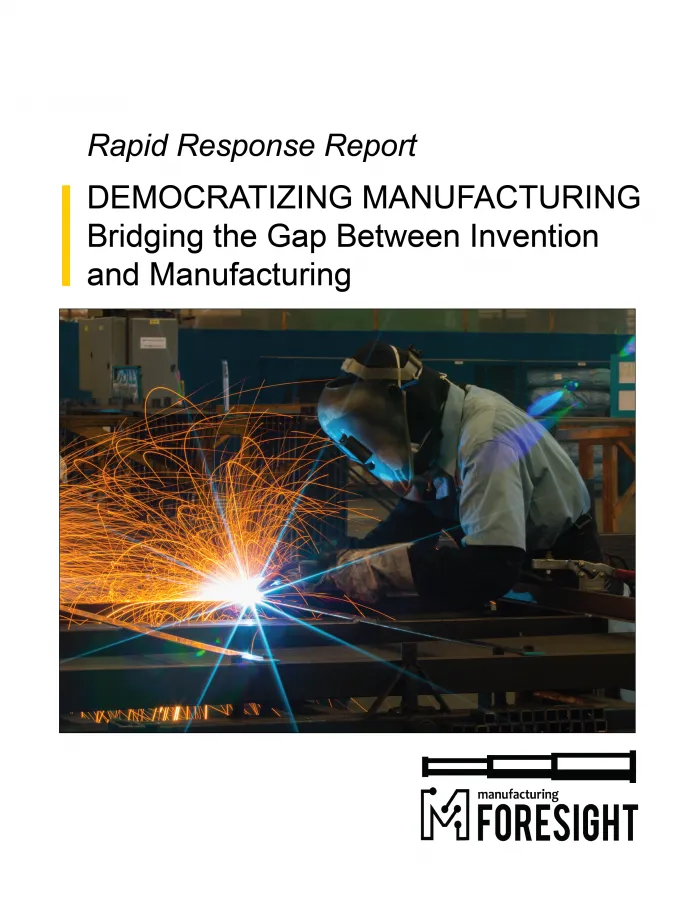DEMOCRATIZING MANUFACTURING
OUTCOMES
IMPACT
Following the release of this report, MForesight began working on an in-depth study to address recommendation #5 below. More information about the follow-on study is available on the project page Supply Chains: A Deep Dive Study.
KEY RECOMMENDATIONS
Based on the workshop discussions, the following recommendations were developed for each topic area to guide policy makers, educators, and industrial partners as they develop initiatives to support small to mid-sized US manufacturers.
1. Democratizing Manufacturing Knowledge:
Create a web-portal to act as a “one-stop shop” with information on capabilities and constraints of various manufacturing processes, materials, software tools, and suppliers.
Educate hardware entrepreneurs about basics of design for manufacturability methods and engage manufacturing experts to provide hands-on training. The suggested training format (M-Corps) should be modeled after the successful NSF I-Corps program.
2. Pathways to Manufacturing Careers:
Establish programs to expose middle school students to technology and manufacturing through field trips and mobile demonstrations.Integrate proven hands-on programs such as FIRST Robotics directly into the mainstream K-12 curriculum rather than as after-school activity.
Encourage private sector to collaborate with local high schools to develop targeted vocational training classes to tap into the pool of non-college-bound students.
Embrace apprenticeships and industrial internships as a proven method for training a skilled manufacturing workforce.
3. Process Innovations:
Federal science and technology agencies are urged to increase their focus on engineering research related to design synthesis and manufacturing process innovations.
Additional R&D investment is needed to support manufacturing processes for low-volume manufacturing.
Promote the creation of intelligent software design tools that detect design aspects that are not manufacturable and suggest alternate solutions.
Support the development of process compilers for common manufacturing processes (such as injection molding, stamping, pressure die casting, etc.) to automatically generate process steps from a CAE design.
4. Manufacturing Business Formation and Growth:
Develop a comprehensive matchmaking site to link inventors, entrepreneurs with suppliers and customers. It is especially important that the site include the procurement needs of Department of Defense.
Leverage the resources (hardware and software) and expertise at local universities to lower barriers to access to digital design and manufacturing tools by small and medium-sized manufacturers (SMMs).
Promote the formation of manufacturing businesses (job-shops for CNC machining or injection molding) using a franchise model, leveraging existing products and services from U.S.-based manufacturers of equipment, federal and state level business equipment loans guarantees, and community-college based skills training for the public.
Promote reshoring and on-shoring of manufacturing through programs that train manufacturers on Total Cost of Ownership tools that calculate true cost of off-shore manufacturing.
5. Improved Access to the U.S. Supply Chain: An in-depth study is recommended to identify the strategies used to increase participation by small to mid-sized manufacturers in the supply chain. Topic areas can include:
• A review of efforts to better match suppliers with customers, and to improve collaboration, investment, and information flow within supply chains.
•An examination of purchasing practices typically found at OEMs that strengthen their relationship with small to mid-sized suppliers while meeting performance and financial metrics.
•A review of successful efforts that have leveraged existing federal technology assets (such as the MEP and Manufacturing USA Institutes) to promote innovation throughout the supply chain.
Implementation of these recommendations could enable and empower individual innovators and small companies to more quickly and cost-effectively transition their initial prototypes into products that can be competitively manufactured in the U.S.

DISSEMINATION
A draft of the report was released at the 2016 MForesight National Summit where 120+ people heard about the recommendations. Attendees at the Summit included members of industry, academia, and government, all with an interest in manufacturing.
The report was finalized and released online in December 2016.
Overview/Motivation
In recent years, the variety and value of the manufactured products that an individual or small team can design and prototype has increased due to a variety of reasons (lower cost of desktop equipment, CAD software, shared Makerspaces, etc.). We believe that these trends could foster manufacturing innovation, and are interested in informing a national agenda to make the most of these opportunities. We gathered a small group of innovators and manufacturers to discuss:
What advances in hardware, software, and services would have the biggest impact on increasing the variety and value of what an individual could design, prototype, and manufacture?
How can entrepreneurs best be supported to make the transition from “making” to low-volume manufacturing?
What are the barriers that entrepreneurs and SMMs (small and medium-sized manufacturers) face when trying to access an established supply chain?
How can we lower barriers to accessing new technologies by SMMs?
Workshop Agenda
AUGUST 8-9, 2016
WASHINGTON MARRIOTT AT METRO CENTER
SESSION 1: TRANSITIONING MAKERS TO MANUFACTURERS
1. Democratization of Manufacturing Knowledge
• Manufacturing 101 Education and Training Modules
• Software tools on Design for Manufacturing; Intelligent CAD tools
2. Leveraging Existing Resources – Best Practices
3. Role of MEPs
SESSION 2: INNOVATIVE APPROACHES TO LOW-VOLUME MANUFACTURING
• Overview of hardware and software challenges
• R&D for a new-generation of equipment and software to increase the variety and value of what individuals and small teams can design, prototype and manufacture
BREAKOUT: PART 1: HARDWARE
• Discuss manufacturing hardware to enable low volume manufacturing (and prototyping)
BREAKOUT: PART 2: SOFTWARE
• Discuss manufacturing software tools to enable low volume manufacturing (and prototyping) and small team designProduct-specific Apps built on general purpose CAE software
SESSION 3: ENCOURAGING FORMATION OF MANUFACTURING BUSINESSES
• Manufacturing businesses that can be franchisedModels that worked (ex; MakeTime.com, Collaborative manufacturing)
• Role of government (local, state, federal)Reduce the cost of access to and increase the usability of existing manufacturing equipment and processes
SESSION 4: LOWER BARRIERS-TO-ACCESS TO ESTABLISHED SUPPLY CHAINS FOR MANUFACTURING ENTREPRENEURS
• Technical and non-technical barriers to access the supply chain
• Emerging trends in supply chains
BREAKOUT: SOLUTIONS FOR ENTREPRENEURS TO ACCESS THE SUPPLY CHAIN
• New technologies that are reducing barriers to entry to the supply chainNew technologies needed to further reduce barriers to the supply chain
• Effect of new business models on supply chains
Contributors
PRIMARY AUTHORS OF THE REPORT
(In alphabetical order)
• Glenn Daehn, Mars G. Fontana Professor of Metallurgical Engineering, Department of Materials Science and Engineering, The Ohio State University
• James Ervin, Technical Expert, Ford Motor Company
• Sridhar Kota, Executive Director, MForesight: Alliance for Manufacturing Foresight
• Michael Russo, U.S. Corporate Lead Government Relations, Regulatory Affairs & Strategic Initiatives, GLOBALFOUNDRIES
• Charles Wessner, Professor, Global Innovation Policy, Georgetown University
MForesight’s work was supported by the National Science Foundation from 2015 to 2020 under Grant No. 1552534 to the University of Michigan (Dr. Sridhar Kota).
Please note that any opinions, findings, and conclusions or recommendations expressed on this website do not necessarily reflect the views of the National Science Foundation or the University of Michigan.

